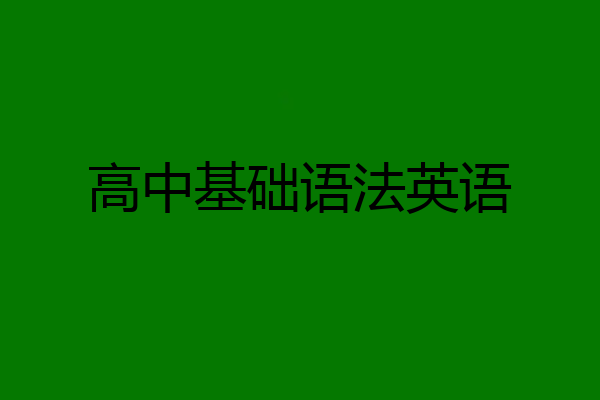
蓝色晚风blue
高中英语语法知识归纳
名词性从句重难点
1. 在名词性从句中,疑问句要用陈述句的语序。例如:
①Can you make sure ____the gold ring ?(MET90)
A.where Alice had put D.where has Alice put
2. 动词 doubt 用在疑问句或否定句中,其后宾语从句常用 that 作连接词;用在肯定句中,连接词用 whether 或 if 皆可,而不用 that。
3. 否定转移问题。
①将think, believe, suppose, expect, fancy, guess, imagine等动词后面跟宾语从句时否定转移 我想我并不认识你。 我相信他不回来。
We dont expect he will come tonight , will he ?
注意:若谓语动词为hope,宾语从句中的否定词不能转移。 I hope you werent ill. 我想你没有生病吧。
②将seem, appear 等后的从句的否定转移
看来他们不知道往哪去。
看来我们明天不会碰上好天气。
4. 主谓一致问题。 . .
5. 语气问题
① 在含有 suggest , order , demand , propose , command , request , insist, desire, require, advise 等表示要求、命令、建议、决定等意义的动词后,that从句常用“should+ 动词原形”的结构 我建议我们应该立刻出发。
② 在It is +过去分词+that的主语从句中 decided,demanded,desired,insisted,ordered,proposed,suggested,recommended,requested, required等。
It is desired that we(should)get everything ready this evening.
③ 在表语从句或同位语从句中
The suggestion that the mayor (should) present the prizes was accepted by everyone.
高中英语语法常考知识
一、名词可数与不可数及修饰词:
常考的抽象名词有:advice, chalk, furniture, patience, paper, clothing, fun, power, work, oil, jewelery, homework, sugar, information, salt, knowledge, luck, weather, progress, news (word), money
注意:another不能修饰不可数名词,可说another book,不可说another news。
二、复合名词的复数形式因词而异:
1. a man driver (men drivers) a woman doctor ( women doctors)
2. a film-goer (film-goers) 电影爱好者
3. a looker-on (lookers-on) 旁观者 passers-by
4. a grown-up (grown-ups) 成年人
三、部分名词的复数形式表示特殊意义:
goods, looks(表情、外貌), manners, papers, greens(青菜、蔬菜), irons(熨斗), forces(军队), sands(做作的样子、架子) →put on airs 3. Wood can be made into paper.
He likes going out for fresh air.
四、
1. 单复数相同:sheep, deer, fish, Chinese, Japanese, means, works
2. 只有复数:cattle, people
3. 常以复数形式出现:trousers, glasses, thanks, clothes, remains(遗物), contents, goods, congratulations, means, sports, preparations(准备), tears, repairs, regards, games(运动会)
4. 以s结尾的学科或专有名词常作单数:
politics, maths, physics, the United States, The United Nations
五、几组易错名词的.用法:
1. many a + 单数名词 = many + 复数名词
2. 集合名词:family, team, audience, enemy, public, group, class, government, company, police, party 作主语时,若看作一个整体时,谓语动词用单数;若表示组成分子,则用复数。
e.g. The police are on duty at the street corner.
My family is / are going to have a long journey.
3. population:
1)作为“人口”的总称或“居民”的总数是不可数名词,谓语用单数。
2)问“多少人口”时,不说how many或how much,而用what。
3)在谈到“人口比多”时,常用large,great;“人口少”时,常用small,而不用much,little。
4)当谈及“有人口”时, 习惯上用have a population of。
5)当“百分数/分数+ of the population”作主语时,谓语用复数。
6)表示某个地区人口时,其前应有定冠词。
7)population不能与people连用。
e.g. The population in China is very large, and 80% of the population are farmers.
The city has a population of the million.
高中英语语法知识
1.名词(nouns)n.:
名词是词性的一种,也是实词的一种,是指代人、物、事、时、地、情感、概念等实体或抽象事物的词。名词可以独立成句。在短语或句子中通常可以用代词来替代。名词可以分为专有名词(Proper Nouns)和普通名词 (Common Nouns),专有名词是某个(些)人,地方,机构等专有的名称,如Beijing,China等。普通名词是一类人或东西或是一个抽象概念的名词,如:book,sadness等。
2.代词(pronoun)pron.:
代词是代替名词的一种词类。大多数代词具有名词和形容词的功能。英语中的代词,按其意义、特征及在句中的作用分为:人称代词、物主代词、指示代词、反身代词、相互代词、疑问代词、关系代词、连接代词和不定代词九种。
3.数词(numeral)Num.:
表示“多少”和“第几”的词,叫数词。其用法相当于名词或者形容词。数词分为基数词和序数词两种。
4.形容词(adjective)adj.或a.;
很多语言中均有的主要词类中的一种。主要用来修饰名词的词,表示事物的特征。形容词用来修饰名词或代词,表示人或事物的性质、状态,和特征的程度好坏,与否。
5.副词(adverb)adv.:
是一种用来修饰动词、形容词、全句的词,说明时间、地点、程度、方式等概念的词。副词是一种半虚半实的词。副词可分为:时间副词、地点副词、方式副词、程度副词、疑问副词、连接副词、关系副词、频率副词和说明性副词等。
6.动词(Verb)v.:
动词,就是用来形容或表示各类动作的词汇。基本上每个完整的句子都有一个动词,要表示第二个动作时可使用不定词、动名词、对等连接词、从属连接词或增加子句等方法连结。


en20120705
高中英语基础语法入门
英语口语的锻炼是一个循序渐进的过程,现实学习中可以借助英语口语入门培训、一对一电话英语等各种资源平台, 将自己的英语口语得到完善。以下是我整理的关于高中英语基础语法入门,希望大家认真阅读!
专题一:英语句子的考点集汇,讲解和训练
一.陈述句的构成形式及基本用法
1.陈述句:
陈述句是用来陈述一个事实或表达说话人看法(包括肯定和否定)的句子。通常用降调,句末用句号“.”。
Tomhasanewcar.
Theflowerisn’tbeautiful.
二.祈使句的构成形式及基本用法
祈使句是用来表示命令、请求、建议、号召等的句子,谓语动词用原形,句末用感叹号“!”或句号“.”。朗读时一般用降调。
1.肯定的祈使句:
(1)祈使句主语是you时,you常省略,但如果要特别强调对方或表达某种强烈的情绪时可以有主语或称呼语。
Bequiet.
Youbequiet!
(2)“Do+祈使句”表示一种强烈的感情或请求,do起强调作用。
Docomebackatonce!
Dobecareful.
2.否定祈使句通常以Don’t或Never开头。其结构通常是:“Don’t(Never)+动词原形+其他成分”例如:
Don’tdothatagain!
Neverleavetoday’sworkfortomorrow!
Don’tbelatenexttime!
三.一般疑问句、特殊疑问句、选择疑问句、反意疑问句的构成形式及基本用法
1.一般疑问句:
(1)一般疑问句的肯定形式
一般疑问句一般是指以助动词、情态动词、be动词或have(有)开始,通常要求以yes,或no来回答的疑问句,一般疑问句读时通常用升调。
DoyouknowMr.Smith?
Canyouswim?
2.特殊疑问句
特殊疑问句由“疑问代词或疑问副词+一般疑问句”构成,句子一般用倒装语序,但如果主语是疑问代词或由疑问代词修饰时,用陈述句的语序。特殊疑问句不能用yes或no回答,读时用降调。例如:
Whoisondutytoday?
HowlonghaveyoubeeninBeijing?
Whattimedoyougetupeverymorning?
WhatmustIdonow?
3.选择疑问句:
选择疑问句是说话者提出两种或两种以上的不同情况,让对方选择回答的疑问句。其结构是“疑问句+选择部分”。选择部分由or连接,or前面的部分读升调,or后面的部分读降调。
选择疑问句不能用yes或no回答,而必须具体的选择答复。
Isyourbagyelloworblack? It’sblack.
Wouldyoulikesometeaorcoffee? Eitherwilldo.
Whichdoyoulikebetter,singingordancing? Ilikedancingbetter.
4.反意疑问句:
反意疑问句是指在陈述句之后附加一个意思与之相反的简短问句,问对方是否赞同的疑问句。附加问句的.否定式必须缩写。
(1)肯定的陈述句后跟否定的附加问句,否定的陈述句后跟肯定的附加问句。
Iamyourteacher,aren’tI?
Hedidn’tstudyhard,didhe?
(2)如果陈述句中含有否定副词never(从不,决不),hardly(几乎不)或其他表示否定代词或形容词,如nothing,nonenoone,nobody,neither,few,little等,则附加问句只能用肯定式。如:
Theyhardlywritetoeachother,dothey?
Hehasfoundnothing,hashe?
Fewpeopleknewthesecret,didthey?
---Youwon’tbeawayforlong,willyou?你不会离开太久,是吗?
---Yes,Iwill.不,我会离开很久。
---No,Iwon’t.是的,我不会离开很久。
-
四.由what,how引导的感叹句的构成形式、用法及区别
感叹句是表示喜、怒、哀、乐以及惊异等感情的句子。句末用感叹号“!”,读时用降调,感叹句往往由what或how引导,what修饰名词,how修饰形容词,副词或动词。
1.what引导的感叹句:
(1)what+a/an+形容词+单数可数名词+陈述句(主语+谓语)
Whatabeautifulcityitis!
Whataninterestingstoryshetold!
(2)what+形容词+复数可数名词/不可数名词+陈述句(主语+谓语)
Whatexpensivewatchestheyare!
Whatterribleweatheritis!
2.How引导的感叹句:
(1)How+形容词/副词+陈述句(主语+谓语)
Howcolditis!
Howhardheworks!
(2)How+陈述句(主语+谓语)
Howheloveshisson!
HowImissyou!
(3)How+形容词+a/an+单数可数名词+陈述句(主语+谓语)
Howtallatreeitis!
(4)上述两种感叹句可以互相转换。例如:
Whatacleverboyheis!→Howclevertheboyis!
Whatacolddayitis!→Howcolditis!
简单句
简单句根据语法形式,即句子的结构,英语的句子可分为简单句、并列句和复合句。
简单句的基本形式是由一个主语加一个谓语构成。其它各种句子形式都是由此句型发展而来,如五大基本句型:
1.基本句型一:SV主+谓)
主语+谓语,这种句型简称为主谓结构,其谓语一般都是不及物动词,例:
Thingschange.事物是变化的。
Nobodywent.没有人去。
--Didyougobysea?你们走的是海路吗?
--NO,weflew.不,我们是飞去。
2.基本句型二:SVP(主+系+表)
这种句型称为主系表结构,其实连系动词在形式上也是一种谓语动词,但实质上表语成了谓语,例:
Mr.Turnerisanartist.特纳先生是位画家。
Themilkturnedsour.牛奶变酸了。
Shebecamealawyer.她当了律师。
常见的系动词有be(am,are,is),turn,go,become,grow,turn,fall,get,go,come,run,keep,rest,remain,stay,lie,stand,feel,smell,sound,taste等.
3.基本句型三:SVO(主+谓+宾)
这种句型可称为主谓宾结构,它的谓语一般多是及物动词,例:
Weneverbeatchildren.我们从来不打孩子。
Mysisterwillfixeverything.我姐姐会料理一切。
4.基本句型四:SVoO(主+谓+间宾+直宾)
这种句型可称为主谓双宾结构,其谓语应是可有双宾语的及物动词,两个宾语一个是间接宾语,一个是直接宾语,例:
Hegavethebooktohissister.他把这本书给了他的妹妹。
I'llwriteyoualongletter.我将写给你一封长信。
5.基本句型五:SVOC(主+谓+宾+宾补)
这种句型可简称为主谓宾补结构,其补语是宾语补语,与宾语一起即构成复合宾语,例:
Ifoundthebookeasy.我发现这本书不难。
Hefoundhisnewjobboring.
Thisplacedhiminaverydifficultposition.
I'lllethimgo.我将让他去。(不定式go用作补语)
Didyounoticehimcomein?
注意:有时两个或更多的并列主语拥有一个共同的谓语,甚至并列有两个主语和两个谓语,这样的句子仍然是简单句,例:
ChinaandothercountriesintheeastAsiaaredevelopingrapidly.中国和东亚其它国家正在迅速地发展。(Chinaandothercountries并列主语)
Mr.WangandIoftenworktogetherandhelpeachother.王先生和我常在一起工作互相帮助。
专题二:宾语从句考点集汇,讲解和训练
一.宾语从句的种类
宾语从句是一种名词性从句,在句中作宾语,根据引导宾语从句的不同连词,宾语从句可分为三类。
1.由that引导的宾语从句。That只有语法作用,没有实在的意义,在口语
和非正式文体中可以省略。例如:
Hesaid(that)hewantedtostayathome.
Shedoesn’tknow(that)sheisseriouslyill.
Iamsure(that)hewillsucceed.
2.由连接代词who,whom,whose,what,which和连接副词when,where,why,how引导的宾语从句。这些连接代词和连接副词在宾语从句中充当某个成分。例如:
Doyouknowwho(whom)theyarewaitingfor?
Heaskedwhosehandwritingwasthebest.
CanyoutellmewheretheNo.3busstopis?
Idon’tknowwhythetrainislate.
3.由if或whether引导的宾语从句。If和whether在句中的意思是“是否”。例如:
Iwanttoknowif(whether)helivesthere.
Heaskedmewhether(if)Icouldhelphim.
二.宾语从句的语序
宾语从句的语序应为陈述句的语序。例如:
Ihear(that)physicsisn’teasy.
Ithink(that)youwilllikethisschoolsoon.
CanyoutellmehowIcangettozoo?
Pleasetellmewhenwe’llhavethemeeting.
三.宾语从句的时态
1.如果主句的时态是一般现在时,宾语从句该用什麽时态就用什麽时态。例如:
Idon’tthink(that)youareright.
Pleasetelluswhereheis.
CanyoutellmehowIcangettotherailwaystation?
2.如果主句的时态是一般过去时,宾语从句只能用相应的过去时态(一般过去时,过去进行时,过去将来时,过去完成时)。例如:
Heaskedwhattimeitwas.
Hetoldmethathewaspreparingforthesportsmeet.
HeaskedifyouhadwrittentoPeter.
HesaidthathewouldgobacktotheU.S.soon.
3.如果宾语从句所陈述的是客观真理,其时态常用一般现在时。例如:
OurteachersaidthatJanuaryisthefirstmonthoftheyear.
Scientistshaveprovedthattheearthturnsaroundthesun.
专题三:状语从句的考点集汇,讲解和训练
用来修饰主句中的动词,副词和形容词的从句叫状语从句。根据其含义状语从句可分为时间状语从句,地点状语从句,条件状语从句,原因状语从句,结果状语从句,比较状语从句,目的状语从句,让步状语从句。
1.时间状语从句
(1)时间状语从句常用when,as,while,before,after,since,till,until,assoonas等连词来引导。例如:
ItwasraininghardwhenIgottoschoolyesterday.
Whilehewasdoinghishomework,thetelephonerang.
Ashewalkedalongthelake,hesanghappily.
HehadlearnedalittleChinesebeforehecametoChina.
Afterhefinishedmiddleschool,hewenttoworkinafactory.
(2)在时间状语从句里,通常不用将来时态,用现在时态表示将来的动作或状态。例如:
I’llringyouupassoonasIgettoNewYork.
Iwilltellhimeverythingwhenhecomesback.
Hewon’tbelieveituntilheseesitwithhisowneyes.
2.条件状语从句
(1)条件状语从句通常由if,unless引导。例如:
Whatshallwedoifitsnowstomorrow?
Don’tleavethebuildingunlessItellyouto.
(2)在条件状语从句里,谓语动词通常用现在时态表示将来的动作或状态。例如:
I’llhelpyouwithyourEnglishifIamfreetomorrow.
Hewon’tbelateunlessheisill.
(3)“祈使句+and(or)+陈述句”在意思上相当于一个带有条件状语从句的复合句。例如:
Hurryup,oryou’llbelate.
=Ifyoudon’thurryup,you’llbelate.
Studyhardandyouwillpasstheexam.
=Ifyoustudyhard,youwillpasstheexam.
3.原因状语从句
原因状语从句通常由because,since,as引导。例如:
Hedidn’tcometoschoolbecausehewasill.
Asitisraining,weshallnotgothezoo.
Sinceyoucan’tanswerthequestion,I’llasksomeoneelse.
4.结果状语从句
(1)结果状语从句由so…that,such…that,sothat引导。例如:
Heissopoorthathecan’tbuyabikeforhisson.
Sheissuchagoodteacherthateverybodylikesher.
Mypencilfellunderthedesk,sothatIcouldn’tseeit.
(2)so…that语such...that可以互换。例如:
在由so...that引导的结果状语从句中,so是副词,与形容词连用。其结构是:“...so+形容词(副词)+that+从句”。例如:
Hewassogladthathecouldn’tsayaword.
Thehallissobigthatitcanhold2,000people.
Motherlivessofarawaythatwehardlyeverseeher.
有时上述两种结构是可以互换的。例如:
Itwassuchawonderfulfilmthatallofuswantedtoseeitagain.
=Thefilmwassowonderfulthatallofuswantedtoseeitagain.
Itissuchanimportantmatchthatnobodywantstomissit.
=Thematchissoimportantthatnobodywantstomissit.
5.比较状语从句
比较状语从句通常由as…as,比较级+than…等连词引导。例如:
TomrunsfasterthanJohndoes.
Thisclassroomisasbigasthatone.
6.目的状语从句
(1)目的状语从句通常由sothat,inorderthat引导。例如:
Westartedearlysothatwecouldcatchthefirsttrain.
Hestudieshardsothathecouldworkbetterinthefuture.
Weusedthecomputerinorderthatwemightsavetime.
(2)sothat既可引导目的状语从句,又可引导结果状语从句。区别这两种从句的办法有两个:1)目的状语从句里往往带有情态动词can,could,may,might等。2)从意思上看,目的状语从句往往表示的目的很明确。例如:
Speakclearlysothattheymayunderstandyou.(目的状语从句)
Jackisbadlyillsothathehastorest.(结果状语从句)
7.让步状语从句
(1)让步状语从句通常由although,though等连词引导。例如:
Thoughheisyoung,heknowsalot.
AlthoughIamtired,Imustgoonworking.
(2)although(though)不能用在同一个句子中。例如:
我们不能说:Thoughitwasraininghard,buthestillwentout.
应该说:Thoughitwasraininghard,hestillwentout.或Itwasraininghard,buthestillwentout.
8.地点状语从句
地点状语从句常常由where来引导。例如:
Gowhereyoulike.
Wherethereisawill,thereisaway.
专题四:定语从句的考点集汇,讲解和训练
一.定语从句的功用和结构
在复合句中,修饰某一名词或代词的从句叫做定语从句。被定语从句修饰的词叫做先行词。定语从句必须放在先行词之后。引导定语从句的关联词有关系代词和关系副词。例如:
Thisisthepresentthathegavemeformybirthday.
Doyouknoweverybodywhocametotheparty?
IstillrememberthenightwhenIfirstcametothevillage?
ThisistheplacewhereChairmanMaooncelived.
二.关系代词和关系副词的功用
关系代词和关系副词用来引导定于从句,在先行词和定语从句之间起纽带作用,使二者联系起来。关系代词和关系副词又在定语从句中充当一个成分。关系待客做主语,宾语,定语,关系副词可作状语。
1.作主语:关系代词在定语从句中作主语时,从句的谓语动词的人称和数须和先行词一致。例如:
Idon’tlikepeoplewhotalkmuchbutdolittle.
ThecarswhichareproducedinHubeiProvincesellverywell.
2.作宾语:
SheisthepersonthatImetattheschoolgateyesterday.
Thebookthatmygrandmothergavemeiscalled“TheGreatEscape”.
3.作定语
关系代词whose在定语从句中作定语用。例如:
What’sthenameoftheyoungmanwhosesisterisadoctor?
Thegirlwhosefatherisateacherstudiesveryhard.
4.作状语
I’llneverforgetthedaywhenIfirstcametoBeijing.
ThisisthehousewhereIwasborn.
三.各个关系代词和关系副词的具体用法
1.who指人,在定语从句中作主语。例如:
Thepersonwhobrokethewindowmustpayforit.
Theboywhoiswearingtheblackjacketisveryclever.
2.whom指人,在定语从句中作宾语。例如:
Doyouknowtheyoungman(whom)wemetatthegate?
MrLee(whom)youwanttoseehascome.
3.whose指人,在定语从句中作定语。例如:
Thegirlwhosemotherisillisstayingathometoday.
Iknowtheboywhosefatherisaprofessor.
4.which指物,在定语从中作主语或宾语。例如:
Adictionaryisabookwhichgivesthemeaningofwords.
Hereisthebook(which)theteachermentionedyesterday.
5.that多指物,有时也指人,在定语从句中作主语或宾语。例如:
I’vereadthenewspaperthat(which)carriestheimportantnews.
Whoisthepersonthatisreadingthenewspaperoverthere?
6.when指时间,在定语从句中作状语。例如:
I’llneverforgetthetimewhenweworkedonthefarm.
HearrivedinBeijingonthedaywhenIleft.
7.where指地点,在定语从句中作状语。例如:
Thisisthehousewherewelivedlastyear.
Thefactorywherehisfatherworksisintheeastofthecity.
四.关系代词whom,which在定语从句中作介词宾语时,可以和介词一起放于先行词与定语从句之间,有时为了关系紧凑也可以将whom与which与先行词紧挨着书写,而将介词置于定语从句的后面,如:Thatwastheroominwhichwehadlivedfortenyears.=Thatwastheroom
whichwehadlivedinfortenyears.
五.具体使用时还要注意下列问题:
1.只能使用that,不用which的情况:
(1)先行词是all,few,little,nothing,everything,anything等不定代词时。
例如:
Allthathesaidistrue.
(2)先行词被only,no,any,all,等词修饰时。例如:
Heistheonlyforeignerthathasbeentothatplace.
(3)先行词是序数词或被序数词修饰的词。例如:
Hewasthesecond(person)thattoldmethesecret.
(4)先行词是形容词最高级或被形容词最高级修饰的词。
Thisisthebestbook(that)Ihavereadthisyear.
(5)先行词既包括人又包括物时。例如:
Hetalkedaboutthepeopleandthethingsheremembered.
2.只能用which,不用that的情况:
(1)在非限制性定语从中。例如:
Themeetingwasputoff,whichwasexactlywhatwewanted.
(2)定语从句由介词+关系代词引导,先行词是物时。例如:
Thethingaboutwhichheistalkingisofgreatimportance.